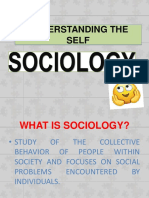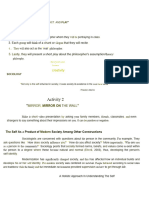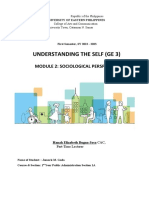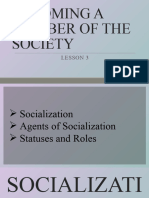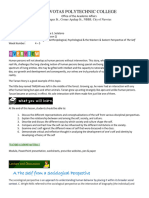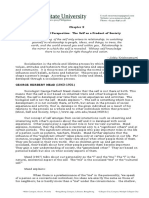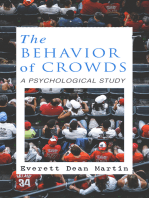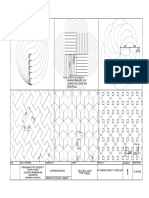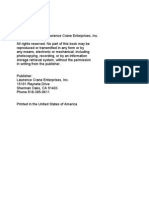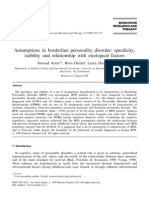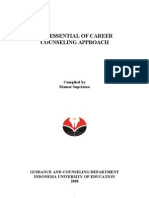Module Title: at The End of The Course, You Are Expected To
Module Title: at The End of The Course, You Are Expected To
Uploaded by
Mike Jacson BautistaCopyright:
Available Formats
Module Title: at The End of The Course, You Are Expected To
Module Title: at The End of The Course, You Are Expected To
Uploaded by
Mike Jacson BautistaOriginal Description:
Original Title
Copyright
Available Formats
Share this document
Did you find this document useful?
Is this content inappropriate?
Copyright:
Available Formats
Module Title: at The End of The Course, You Are Expected To
Module Title: at The End of The Course, You Are Expected To
Uploaded by
Mike Jacson BautistaCopyright:
Available Formats
Study Guide in Understanding The Self Module 2 The Self From Various Perspective/ The Self As
a Product of Modern Society Among Other Constructions
Module No. 2
MODULE TITLE
The Self From Various Perspectives
The Self As a Product of Modern Society among Other Constructions
MODULE OVERVIEW
In this chapter, the student will understand the construct of the self from various disciplinal
perspectives. The student will also reflect on a concrete experience on a holistic point of view.
LEARNING OBJECTIVES
At the end of the course, you are expected to:
Discuss the different representations and conceptualizations of the self from various
disciplinal perspectives;
Compare and contrast how the self has been represented across different disciplines and
perspectives;
Examine the different influences, factors, and forces that shape the self; and
Demonstrate critical and reflective thought in analyzing the development of one’s self
and identify by developing a theory of the self.
LEARNING CONTENTS
Different Perspective in the Explanation of Self
The Self As a Product of Modern Society among Other Constructions
Key Characteristics of Modernity
Social groups and Social Network
Mead and the Social Self
Developing the Self
Two Sides of self: “I” and “Me”
LEARNING POINTS
THE SELF AS A PRODUCT OF MODERN SOCIETY AMONG OTHER
CONSTRUCTIONS
Sociologists are concerned with questions about the person in the community. For example,
they ask questions, like “ How does society influence you?” How do yo affect society?” More
importantly, “Who are you as a person in the community/” Sociologist posits that socially formed
PANGASINAN STATE UNIVERSITY 1
Study Guide in Understanding The Self Module 2 The Self From Various Perspective/ The Self As
a Product of Modern Society Among Other Constructions
norms, beliefs, and values come to exist within the person to a degree where these become natural
and normal (Elwell, 2003), thus developing the person’s self-identity.
Modernization has significantly changed society, and this has affected how an individual
builds and develops his or her self-identity. Pre-modern society was centered on survival. People
behaved according to social rules and traditions while the family and the immediate environment
provided supervision on how to get through life.
Key Characteristics of modernity
According to Giddens (1991), the most patent, major characteristics of modernity are:
1. Industrialism, the social relations implied in the extensive use of material power and machinery
in all processes of production;
2. Capitalism, a production system involving both competetive product markets and the
commodification (putting a price tag) of labor power.
3. Institutions of Surveillance, the massive increase of power and reach by institutions,
especially in government; and
4. Dynamism, the most evident characteristic of a modern society. Dynamism is characterized as
having vigorous activity and progress. In a modern society, life is not a predetermined path with
limited options based on location, family, or gender, it is a society full of possibilities. Everything
is subject to change, and changes happen much more rapidly than ever before in human history.
SOCIAL GROUPS AND SOCIAL NETWORK
Sociologist George Simmel expressed that people create social networks by joining social groups.
Social group is described as having two or more people interacting with one another, sharing similar
characteristics, and whose members identify themselves as part of the group. An example of a social group
is your family, your barkada, your classmates. Meanwhile, social network refers to the ties or connections
that link you to your social group.
Two types of social group
Organic Group
Naturally occurring and it is highly influenced by your family. This is usually formed in traditional
societies because there is little diversity in these communities. Sociologist George Simmel stated that you
join these groups because your family is also a part of it, in the first place. He called it organic motivation.
Rational Groups
Occur in modern societies. Modern societies are made up of different people coming from different
places. Rational Groups are formed as a matter as a shared self-interests; moreover, people join these groups
out of their own free will. Simmel called this rational motivation.
PANGASINAN STATE UNIVERSITY 2
Study Guide in Understanding The Self Module 2 The Self From Various Perspective/ The Self As
a Product of Modern Society Among Other Constructions
MEAD AND THE SOCIAL SELF
“A multiple personality is in a certain sense
normal.”
-George Herbert Mead
George Herbert Mead was a sociologist from the late 1800s.He is well known for his
“theory of the Social Self.” mead’s work focused on how the “self is developed. His theory is
based on the perspective that the self is a product of social interactions and internalizing the
external (i.e., other people’s) views along with one’s personal view about self. Mead believed the
“self” is not present at birth; rather it develop over time through social experiences and activities.
Three Stages of Self-development According to Mead:
1. Language stage- through shared understanding of symbol, gestures, and sound, language gives the
individual the capacity to express himself or herself while at the same time comprehending what the other
people are conveying.
2. Play stage- at this level, individuals role-play or assume the perspective of others. Role-playing enables the person
to internalize some other people’s perspectives; hence he or she develops an understanding of how the other people
feel about themselves (and about others, too) in a variety of situations.
3. Game stage- the level where the individual not only internalizes the other people’s perspectives, he or she is also
able to take into account societal rules and adheres to it. According to Mead, the self is developed by understanding the
rule, and one must abide b it to win the game or be successful at an activity..
TWO SIDES OF THE SELF: “I” and “ME”
PANGASINAN STATE UNIVERSITY 3
Study Guide in Understanding The Self Module 2 The Self From Various Perspective/ The Self As
a Product of Modern Society Among Other Constructions
According to mead, “me” is the product of what the person has learned while interacting
with others and with the environment. Learned behaviors, attitudes, and even expectations
comprise the “me”. The “me” exercises social control over the self. I sees to it that rules are not
broken.
On the other hand, the “I” is that part of the self is unsocialized an spontaneous. It is the
individual’s response to the community’s attitude towards the person. The “I” presents impulses
and drives.
LEARNING ACTIVITIES
See Assignment Tab
REFERENCES
Otig, Vergie S. (2018). A holistic approach in understanding the self. Malabon City: Mutya Publishing
House.
PANGASINAN STATE UNIVERSITY 4
You might also like
- Final Multiple Choice QuestionsDocument14 pagesFinal Multiple Choice Questionsaartikalani80% (10)
- Lesson 1 SociologyDocument37 pagesLesson 1 SociologyElly Gift Bersalona100% (1)
- Performance Appraisal Interview GuideDocument6 pagesPerformance Appraisal Interview Guideshital9099No ratings yet
- PerDev Module 2Document4 pagesPerDev Module 2Sheilou PlanasNo ratings yet
- Uts Lesson 2Document3 pagesUts Lesson 2Marvin SimbulanNo ratings yet
- Ge 1: Understanding The Self: Chapter 2: Sociological Perspective: The Self As A Product of SocietyDocument4 pagesGe 1: Understanding The Self: Chapter 2: Sociological Perspective: The Self As A Product of SocietyZerhan LaarinNo ratings yet
- The Self in The Anthropological ProcessDocument4 pagesThe Self in The Anthropological ProcessQuivy ShunNo ratings yet
- Module 2Document5 pagesModule 2Shane Patrick PanilagNo ratings yet
- THSELF1 Chapter 2 - SociologyDocument5 pagesTHSELF1 Chapter 2 - SociologytawaykhailNo ratings yet
- SociologyDocument4 pagesSociologyalex ortegaNo ratings yet
- Stevens 1996 As Cited by Atlata, Etal.Document7 pagesStevens 1996 As Cited by Atlata, Etal.schoolpeteNo ratings yet
- Lesson 2 - The Self From Various Perspective - SociologyDocument2 pagesLesson 2 - The Self From Various Perspective - SociologyKaryll Heart LayugNo ratings yet
- Activity 2: "Mirror, Mirror On The Wall"Document4 pagesActivity 2: "Mirror, Mirror On The Wall"slow dancerNo ratings yet
- Topic 3 - Sociological PerspectiveDocument12 pagesTopic 3 - Sociological Perspectivehei hei heiNo ratings yet
- Lesson-2 2Document5 pagesLesson-2 2gabrielbandulin1No ratings yet
- Understanding The Self: Chapter 3 - Part 1Document6 pagesUnderstanding The Self: Chapter 3 - Part 1Phee JhayNo ratings yet
- Module 2 Social PerspectiveDocument3 pagesModule 2 Social PerspectiveLara SabunodNo ratings yet
- Sociological Perspective of SelfDocument4 pagesSociological Perspective of Selfkrishelleanne.abobo.24No ratings yet
- The Self From Various Perspectives: SociologyDocument8 pagesThe Self From Various Perspectives: SociologyRENARD CATABAYNo ratings yet
- MODULE 3: Unfolding The Social SelfDocument4 pagesMODULE 3: Unfolding The Social SelfChristian Eleazar LazanasNo ratings yet
- Uts NotesDocument7 pagesUts Noteskarenrinon06No ratings yet
- LESSON 2 Sociological Perspective of The SelfDocument5 pagesLESSON 2 Sociological Perspective of The SelfMary Joy CornelioNo ratings yet
- 2 - Sociology and AnthropologyDocument7 pages2 - Sociology and AnthropologyWinona BartolomeNo ratings yet
- Module 2 - Sociological PerspectiveDocument9 pagesModule 2 - Sociological PerspectiveJomark GudaNo ratings yet
- Identity and Development of SelfDocument10 pagesIdentity and Development of SelfStephen Sills100% (2)
- SociologyDocument4 pagesSociologyJayson BenedictoNo ratings yet
- Quarter 3-Module 3 Becoming A Member of Society: Senior High SchoolDocument12 pagesQuarter 3-Module 3 Becoming A Member of Society: Senior High SchoolYuan Ceralde Salayog100% (1)
- Lesson 3 Week 4 Sociological Perspective of The Self by Sir CSDDocument10 pagesLesson 3 Week 4 Sociological Perspective of The Self by Sir CSDEdgardo IlaoNo ratings yet
- Ucsp SUMMARY MOD 3 AND 4Document2 pagesUcsp SUMMARY MOD 3 AND 4Rheza Mae MancoNo ratings yet
- Lesson 3Document10 pagesLesson 3anonymousacc2303No ratings yet
- GE 1 Module 2Document9 pagesGE 1 Module 2its03mae14No ratings yet
- UCSP Week 7 and 8Document29 pagesUCSP Week 7 and 8Christyl MoraledaNo ratings yet
- Lesson 5Document10 pagesLesson 5XYJON LAROZANo ratings yet
- Uts - Chap.2Document21 pagesUts - Chap.2Darwin Win WinNo ratings yet
- Understanding The Self (Chapter 2 Notes)Document3 pagesUnderstanding The Self (Chapter 2 Notes)Gilchristi MacatoNo ratings yet
- SociologyDocument30 pagesSociologyMhel AriolaNo ratings yet
- Uts NotesDocument29 pagesUts NotesJoses CalindasNo ratings yet
- Module-2 UTSDocument8 pagesModule-2 UTSAlondra MenaNo ratings yet
- UTS Module2 RevisedDocument16 pagesUTS Module2 RevisedjeruscalulangNo ratings yet
- Sociological Perspective: The Self As A Product of SocietyDocument10 pagesSociological Perspective: The Self As A Product of SocietyMarjorie O. MalinaoNo ratings yet
- Chapter 2 Sociological Perspective The Self As A Product of SocietyDocument4 pagesChapter 2 Sociological Perspective The Self As A Product of SocietySAMARITA, SHAINA MARIE J.100% (1)
- View of The SelfDocument10 pagesView of The SelfCherry ArangconNo ratings yet
- Sociological Perspective of SelfDocument2 pagesSociological Perspective of SelfShin GilNo ratings yet
- Section 3-Social SelfDocument4 pagesSection 3-Social Selfrose belle garciaNo ratings yet
- Module Uts Lesson 2Document10 pagesModule Uts Lesson 2ly kaNo ratings yet
- Sociology Wps OfficeDocument2 pagesSociology Wps OfficeMaureen Joyce SantiagoNo ratings yet
- 03 (Presentation) Sociological Perspectives (Sir Eugenio)Document22 pages03 (Presentation) Sociological Perspectives (Sir Eugenio)ROLAND ROBLESNo ratings yet
- Lesson 3 Understanding The Self The Self According To Sociology/AnthropologyDocument6 pagesLesson 3 Understanding The Self The Self According To Sociology/AnthropologyDiana CaballesNo ratings yet
- Sociological-Perspective 2Document7 pagesSociological-Perspective 2Ryan RobenacioNo ratings yet
- Chapter 4 Socialization and Social GroupsDocument34 pagesChapter 4 Socialization and Social GroupsLawren Ira LanonNo ratings yet
- Chapter 2 Sociological PerspectiveDocument15 pagesChapter 2 Sociological PerspectiveStephanie CapistranoNo ratings yet
- Module 5 Social Self Official-1Document34 pagesModule 5 Social Self Official-1SheilaJoyJuarezNo ratings yet
- Ucsp-Las-Q3 WK 4Document7 pagesUcsp-Las-Q3 WK 4Eury CoronelNo ratings yet
- Module 2 - SOCIOLOGICAL PERSPECTIVE OF THE SELFDocument4 pagesModule 2 - SOCIOLOGICAL PERSPECTIVE OF THE SELFJemuel Bucud Lagarto100% (1)
- Understanding Culture, Society and Politics: Self Learning ModuleDocument10 pagesUnderstanding Culture, Society and Politics: Self Learning ModuleFunny JuanNo ratings yet
- Socioloical View The SELFDocument12 pagesSocioloical View The SELFJohn Mark Cortes BalatucanNo ratings yet
- Q1 SLM Ucsp M3Document6 pagesQ1 SLM Ucsp M3Ochavo Smer100% (3)
- US 101 Understanding The SelfDocument9 pagesUS 101 Understanding The SelfJonalyn OmerezNo ratings yet
- THE BEHAVIOUR OF CROWDS: Decoding the Dynamics and Influences of Collective Human Actions (2024 Guide)From EverandTHE BEHAVIOUR OF CROWDS: Decoding the Dynamics and Influences of Collective Human Actions (2024 Guide)No ratings yet
- Sources of EnergyDocument26 pagesSources of EnergyMike Jacson BautistaNo ratings yet
- THEORY 1 Module 1 Study Guide A4 Aug12'20Document31 pagesTHEORY 1 Module 1 Study Guide A4 Aug12'20Mike Jacson BautistaNo ratings yet
- College of Engineering and ArchitectureDocument1 pageCollege of Engineering and ArchitectureMike Jacson BautistaNo ratings yet
- Ohms LawDocument31 pagesOhms LawMike Jacson BautistaNo ratings yet
- At The End of The Course, You Are Expected To:: Module TitleDocument3 pagesAt The End of The Course, You Are Expected To:: Module TitleMike Jacson BautistaNo ratings yet
- Study-Guide-Part 1Document9 pagesStudy-Guide-Part 1Mike Jacson BautistaNo ratings yet
- Unit 1: Various Perspectives of The SelfDocument10 pagesUnit 1: Various Perspectives of The SelfMike Jacson BautistaNo ratings yet
- DESIGN 1 Module 1 Study Guide A4 Aug12'20Document16 pagesDESIGN 1 Module 1 Study Guide A4 Aug12'20Mike Jacson BautistaNo ratings yet
- SAMPLE Research WorkDocument2 pagesSAMPLE Research WorkMike Jacson BautistaNo ratings yet
- Study-Guide-Part 3Document32 pagesStudy-Guide-Part 3Mike Jacson BautistaNo ratings yet
- THEORY 1 Course Guide 1 of 15Document4 pagesTHEORY 1 Course Guide 1 of 15Mike Jacson BautistaNo ratings yet
- Study-Guide-Part 2Document9 pagesStudy-Guide-Part 2Mike Jacson BautistaNo ratings yet
- Short Self Description 1 PDFDocument1 pageShort Self Description 1 PDFMike Jacson BautistaNo ratings yet
- Pangasinan State University College of Engineering and ArchitectureDocument1 pagePangasinan State University College of Engineering and ArchitectureMike Jacson BautistaNo ratings yet
- DESIGN 1 Course Guide 1 of 11Document4 pagesDESIGN 1 Course Guide 1 of 11Mike Jacson BautistaNo ratings yet
- Psu TB 8.5x12 PDFDocument1 pagePsu TB 8.5x12 PDFMike Jacson BautistaNo ratings yet
- Mathematics in Our WorldDocument47 pagesMathematics in Our WorldMike Jacson BautistaNo ratings yet
- SLP InterviewDocument3 pagesSLP Interviewapi-510230689No ratings yet
- TM2.2 Managing DiversityDocument25 pagesTM2.2 Managing DiversityGloriaNo ratings yet
- Screen Time Can Be Dangerous For KidsDocument20 pagesScreen Time Can Be Dangerous For KidsHaya HarareedNo ratings yet
- The Ultimate Truth (About Love & Happiness) A Handbook To Life by Lester LevensonDocument34 pagesThe Ultimate Truth (About Love & Happiness) A Handbook To Life by Lester LevensonAndré Hgz100% (1)
- 8.1. Importance of Providing Meaningful Student Feedback - Center For Teaching Excellence - University of South CarolinaDocument3 pages8.1. Importance of Providing Meaningful Student Feedback - Center For Teaching Excellence - University of South Carolinafayrouzemad4No ratings yet
- Arntz Dietzel Dreessen 99Document13 pagesArntz Dietzel Dreessen 99calmeida_31No ratings yet
- 17 "Flow" Triggers That Will Increase Productivity - Tapping Into Peak Human Performance in BusinessDocument7 pages17 "Flow" Triggers That Will Increase Productivity - Tapping Into Peak Human Performance in BusinessFilipe RovarottoNo ratings yet
- Sensory Enrichment Therapy For AutismDocument7 pagesSensory Enrichment Therapy For AutismCK_2023100% (2)
- EDUC 70 Module 2.2Document4 pagesEDUC 70 Module 2.2Leslie mae GioNo ratings yet
- Marriage Annulment Questionnaire: I. Your Life Before Marriage A. Family BackgroundDocument4 pagesMarriage Annulment Questionnaire: I. Your Life Before Marriage A. Family BackgroundApsary Diamla gtqdl100% (1)
- MCQs Unit 1 Human Resource Management and PlanningDocument16 pagesMCQs Unit 1 Human Resource Management and PlanningMegha100% (2)
- Lesson 1 - IntroductiontoQuali 1Document23 pagesLesson 1 - IntroductiontoQuali 1aliciatomada123No ratings yet
- Episode 6 FS1Document9 pagesEpisode 6 FS1Nole Jr. Tanjay OczonNo ratings yet
- Case Study On New Performance Appraisal System at XeroxDocument2 pagesCase Study On New Performance Appraisal System at XeroxSamrakk92100% (1)
- Application 3: Top-Management Team at Ortiv Glass CorporationDocument2 pagesApplication 3: Top-Management Team at Ortiv Glass Corporationniranjana100% (1)
- Sadomasochism Accor Sadomasochism According To Freud's Psychosexual Stages of Chosexual Stages of Development TheoryDocument10 pagesSadomasochism Accor Sadomasochism According To Freud's Psychosexual Stages of Chosexual Stages of Development TheoryDolce BbNo ratings yet
- 1 Teori Konseling Karir (L)Document37 pages1 Teori Konseling Karir (L)Tisa KhaerunisaNo ratings yet
- The Imposter SyndromeDocument12 pagesThe Imposter SyndromeGustavo Fonseca100% (7)
- Stress Management With Self CareDocument27 pagesStress Management With Self CareNayana ShahNo ratings yet
- HW2 Resubmit MGT4479Document8 pagesHW2 Resubmit MGT4479Giang LêNo ratings yet
- Kuning Hijau Dan Biru Geometris Modern Kesehatan Mental Lokakarya Webinar Presentasi UtamaDocument23 pagesKuning Hijau Dan Biru Geometris Modern Kesehatan Mental Lokakarya Webinar Presentasi Utamaandiade irmaNo ratings yet
- Obsessive AssignmentDocument7 pagesObsessive AssignmentDolly GuptaNo ratings yet
- Grade 9 Quarter 3 Week 1 Biases and Prejudices Day 2 UpdatedDocument30 pagesGrade 9 Quarter 3 Week 1 Biases and Prejudices Day 2 UpdatedJohn Andrew LuisNo ratings yet
- Myths About Time ManagementDocument2 pagesMyths About Time ManagementIliana FloresNo ratings yet
- Miles That Bind: Commuter Marriage and Family StrengthsDocument25 pagesMiles That Bind: Commuter Marriage and Family StrengthsDeshinta Savira IlmawatiNo ratings yet
- Culture: How It Defines Human BehaviorDocument9 pagesCulture: How It Defines Human BehaviorVictoria AntonetteNo ratings yet
- Dance/Movement Therapy: The ProgramDocument2 pagesDance/Movement Therapy: The ProgramAteh HashimNo ratings yet
- Resume - Isabelle KiritsyDocument2 pagesResume - Isabelle Kiritsyapi-509954483No ratings yet

